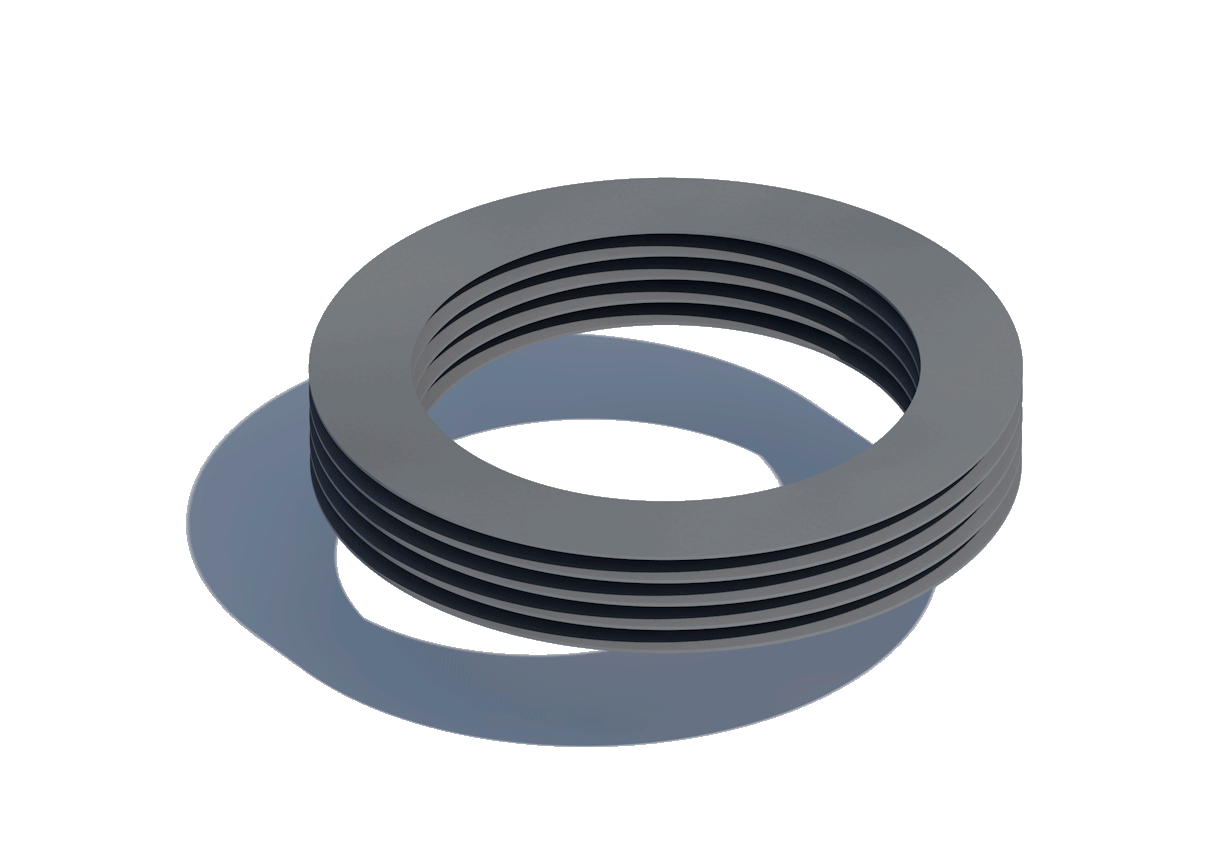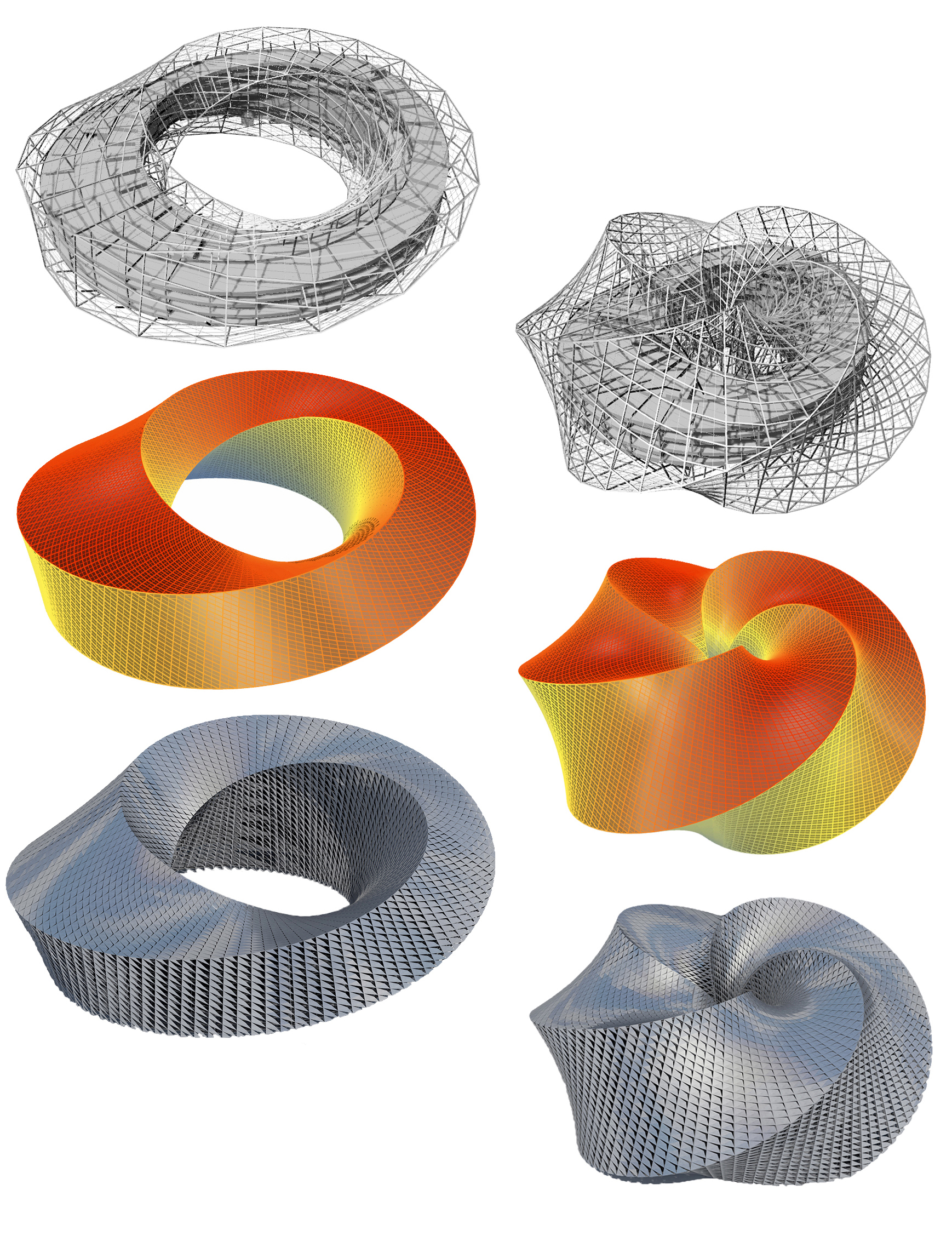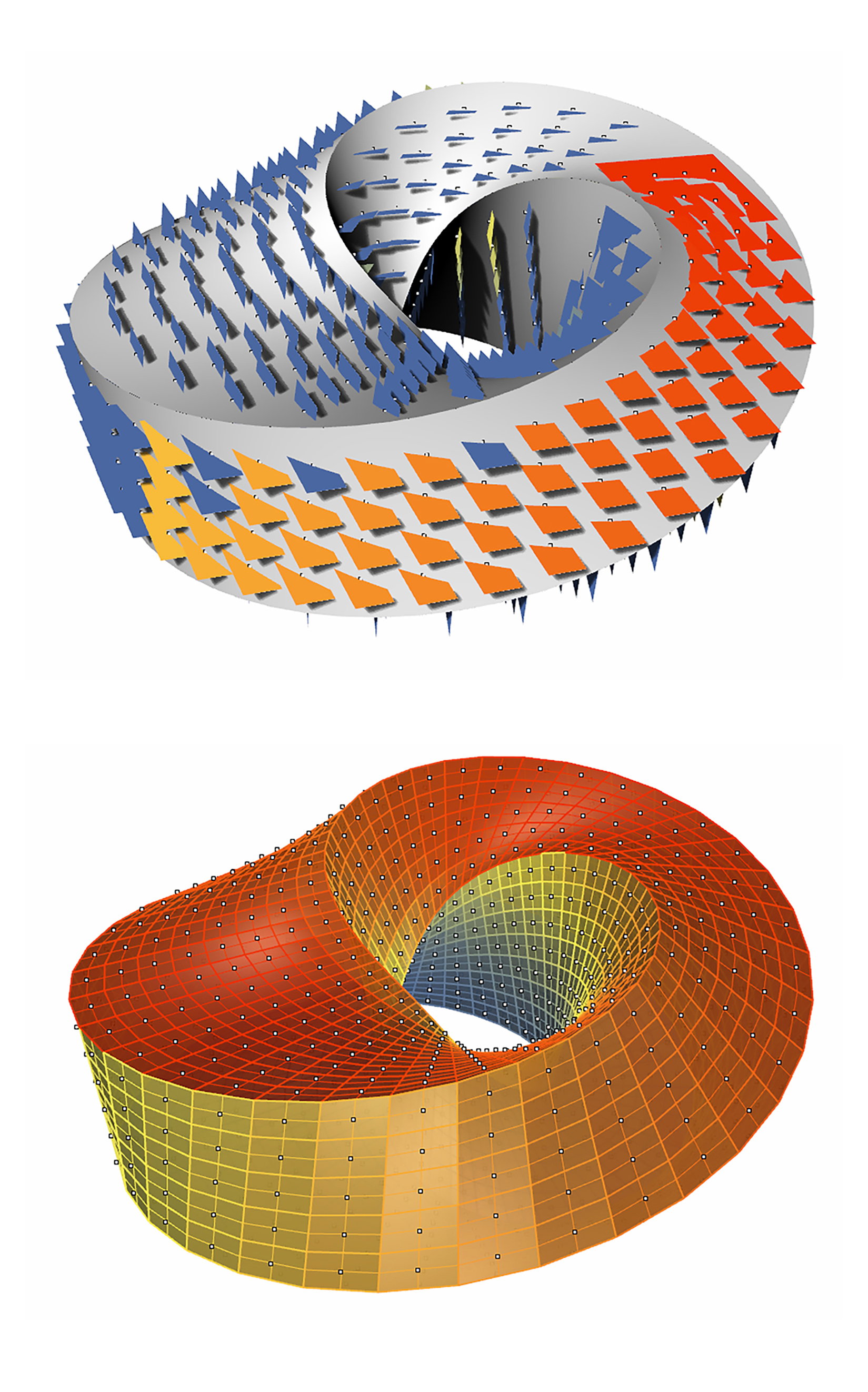Integrated
Algorithmic Design
Master Thesis

Many great architectural endeavors today engage in a multi software approach, as
each party develops their respective part of the project in a different software.
Moreover, the architectural project itself covers many tasks, including 3D modeling,
analysis, and rendering, which benefit from the use of different tools. Combining
them in the same project involves the sharing and crossing of the various
information systems, which is not always a successful process. A mechanism is needed
that connects all the different tools used, in a more effective manner - a
portability mechanism. Algorithmic Design (AD) presents itself as a potential
solution.
AD is an algorithmic approach to architectural design that allows
architects to transcend factory-set limitations of the currently used 3D software.
As mathematical descriptions are oblivious to any software, the algorithmic
descriptions of the designs become independent from the software that might be used
to produce them.
This thesis aims to explore the advantages an algorithmic approach can
bring to the design process, and investigate, at the same time, how to bridge the
gap between the different tools with which architecture currently operates. We
propose a methodology based on an algorithmic approach to design, where a single
program can describe not only the intended model, but also additional tasks, such as
model analysis. We call this approach, Integrated Algorithmic Design (IAD) and using
it, the architect can take advantage of various CAD, BIM and analysis tools, with
little effort when it comes to the transition between them.
Algorithmic Architectural Visualization
CAADRIA Conference: Learning, Adapting and Prototyping
Beijing, China, 2018
Castelo-Branco, Renata & Leitão, António
 Abstract: Digitally-generated visualizations, such as renders or
movies, are, nowadays, commonly used as representation methods for architectural
creations. This occurs not only in final stages of the process, with the goal of
selling the product’s image, but also in midst creation process to express concepts
and ideas. Presently, the spread of parametric and algorithmic approaches to design
creates a problem for visualization, as it enables the almost effortless change of
3D models, thus requiring repeated visualization efforts to keep up with the changes
applied to the design. To solve this, we propose extending the algorithmic design
approach to also include the high-level description of architectural image creation.
The methodology, Algorithmic Architectural Visualization (AAV), also contemplates
the required preparation settings for the visualization process, and includes
possible visualization productions inspired by film techniques.
Abstract: Digitally-generated visualizations, such as renders or
movies, are, nowadays, commonly used as representation methods for architectural
creations. This occurs not only in final stages of the process, with the goal of
selling the product’s image, but also in midst creation process to express concepts
and ideas. Presently, the spread of parametric and algorithmic approaches to design
creates a problem for visualization, as it enables the almost effortless change of
3D models, thus requiring repeated visualization efforts to keep up with the changes
applied to the design. To solve this, we propose extending the algorithmic design
approach to also include the high-level description of architectural image creation.
The methodology, Algorithmic Architectural Visualization (AAV), also contemplates
the required preparation settings for the visualization process, and includes
possible visualization productions inspired by film techniques.
Design Algorítmico Integrado (in portuguese)
pt BIM: 2nd Portuguese BIM Congress
Lisbon, Portugal, 2018
Castelo-Branco, Renata & Leitão, António
 Resumo: Atualmente, o processo de desenvolvimento de um projeto
de arquitetura conta com um leque de ferramentas usadas por cada uma das partes
envolvidas para desenvolver a sua especialidade. A combinação de todas elas num
mesmo projeto obriga à partilha e conversão de dados entre os vários sistemas de
informação, processo que nem sempre é bem-sucedido. Design Algorítmico Integrado
(DAI) é uma abordagem ao projeto de arquitetura, aqui proposta como forma de
ultrapassar as limitações impostas pelas ferramentas de modelação e análise, entre
outras, abrangendo os aspetos e fases mais relevantes do seu desenvolvimento. DAI
defende a produção de uma única descrição algorítmica do projeto - um programa - que
muda e evolui ao longo das diversas fases do processo e contém toda a informação
relativa ao mesmo.
Resumo: Atualmente, o processo de desenvolvimento de um projeto
de arquitetura conta com um leque de ferramentas usadas por cada uma das partes
envolvidas para desenvolver a sua especialidade. A combinação de todas elas num
mesmo projeto obriga à partilha e conversão de dados entre os vários sistemas de
informação, processo que nem sempre é bem-sucedido. Design Algorítmico Integrado
(DAI) é uma abordagem ao projeto de arquitetura, aqui proposta como forma de
ultrapassar as limitações impostas pelas ferramentas de modelação e análise, entre
outras, abrangendo os aspetos e fases mais relevantes do seu desenvolvimento. DAI
defende a produção de uma única descrição algorítmica do projeto - um programa - que
muda e evolui ao longo das diversas fases do processo e contém toda a informação
relativa ao mesmo.
Integrated Algorithmic Design:
A single-script approach for multiple design tasks
eCAADe Conference: ShoCK! Sharing of Computable Knowledge
Rome, Italy, 2017
Castelo-Branco, Renata & Leitão, António
 Abstract: Many great architectural endeavors today engage in a
multi software approach, as each specialty involved needs a different software, and
different task required from the architect, such as 3D modeling, analysis or
rendering, also benefit from the use of different tools. Combining them in the same
process is not always a successful endeavor. A more effective portability mechanism
is needed, and Algorithmic Design (AD) has the potential to become one. This paper
explores the advantages of the algorithmic approach to the design process, and
proposes a methodology capable of integrating the different tools and paradigms
currently used in architecture. The methodology is based on the development of a
computer program that describes not only the intended model, but also additional
tasks, such as the required analysis and rendering. It takes advantage of CAD, BIM
and analysis tools, with little effort when it comes to the transition between them.
Abstract: Many great architectural endeavors today engage in a
multi software approach, as each specialty involved needs a different software, and
different task required from the architect, such as 3D modeling, analysis or
rendering, also benefit from the use of different tools. Combining them in the same
process is not always a successful endeavor. A more effective portability mechanism
is needed, and Algorithmic Design (AD) has the potential to become one. This paper
explores the advantages of the algorithmic approach to the design process, and
proposes a methodology capable of integrating the different tools and paradigms
currently used in architecture. The methodology is based on the development of a
computer program that describes not only the intended model, but also additional
tasks, such as the required analysis and rendering. It takes advantage of CAD, BIM
and analysis tools, with little effort when it comes to the transition between them.
Translating algorithmic design from CAD to BIM
KineSIStem Conference: From Nature to Architectural Matter
Lisbon, Portugal, 2017
Castelo-Branco, Renata & Leitão, António
 Abstract: Nowadays, practitioners are embracing the BIM paradigm,
as it allows a faster development of models using pre-modeled elements and automates
time-consuming tasks such as the production of technical documents. Nevertheless,
CAD tools still provide greater freedom in form creation, which is better suited for
the early and exploratory stages of the project. To take advantage of both
approaches, some practitioners begin designing in CAD environments and, when
satisfied with the overall shape, transition to BIM. This paper addresses the in
between stage of this transition from an Algorithmic Design standpoint. It explains
the main differences between the two paradigms and proposes a modeling methodology,
using a portable algorithmic design tool capable of generating the building’s design
in both CAD and BIM software, which facilitates the translation process of the
building’s description from one paradigm to the other.
Abstract: Nowadays, practitioners are embracing the BIM paradigm,
as it allows a faster development of models using pre-modeled elements and automates
time-consuming tasks such as the production of technical documents. Nevertheless,
CAD tools still provide greater freedom in form creation, which is better suited for
the early and exploratory stages of the project. To take advantage of both
approaches, some practitioners begin designing in CAD environments and, when
satisfied with the overall shape, transition to BIM. This paper addresses the in
between stage of this transition from an Algorithmic Design standpoint. It explains
the main differences between the two paradigms and proposes a modeling methodology,
using a portable algorithmic design tool capable of generating the building’s design
in both CAD and BIM software, which facilitates the translation process of the
building’s description from one paradigm to the other.
Algorithmic-based analysis:
design and analysis in a multi back-end generative tool
CAADRIA Conference: Protocols, Flows and Glitches
Suzhou, China, 2017
Leitão, António & Castelo-Branco, Renata & Cardoso, Carmo
 Abstract: Estimating a building's performance is part of the
engineering and architecture discipline. Nowadays, this estimation is done using
analysis tools. In many cases, these analysis tools require specialized building
models that are simplifications of the actual models. Unfortunately, the adaptations
that need to be done to an existing model are tiresome and make the architect less
willing to evaluate variations of the building design. Moreover, in the case of
buildings with complex shapes, the analyses tend to be less reliable. These problems
also occur when algorithmic approaches are used to generate the building design, as
the algorithmic script needs to be adapted to satisfy the requirements of the
analysis tool, or the manual adaptation of the generated model needs to be repeated
each time the script is executed. To solve these issues we propose Algorithmic-Based
Analysis. This is a Generative Design method that, utilizing a single
algorithmic-based representation of a building, can generate not only the
traditional CAD or BIM model, but also specialized models for use in different kinds
of analysis.
Abstract: Estimating a building's performance is part of the
engineering and architecture discipline. Nowadays, this estimation is done using
analysis tools. In many cases, these analysis tools require specialized building
models that are simplifications of the actual models. Unfortunately, the adaptations
that need to be done to an existing model are tiresome and make the architect less
willing to evaluate variations of the building design. Moreover, in the case of
buildings with complex shapes, the analyses tend to be less reliable. These problems
also occur when algorithmic approaches are used to generate the building design, as
the algorithmic script needs to be adapted to satisfy the requirements of the
analysis tool, or the manual adaptation of the generated model needs to be repeated
each time the script is executed. To solve these issues we propose Algorithmic-Based
Analysis. This is a Generative Design method that, utilizing a single
algorithmic-based representation of a building, can generate not only the
traditional CAD or BIM model, but also specialized models for use in different kinds
of analysis.